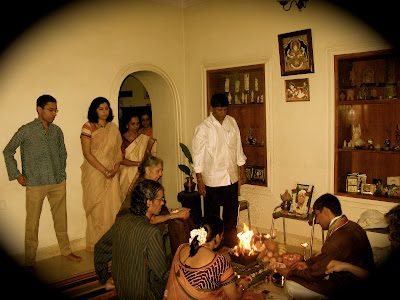Today would have been my father’s 78th birthday. I
am posting a poem written by him on a long-standing effort by him to get my
mother to trade wearing sarees and chappals (slippers) for wearing salwar kameezes and shoes, when they
traveled. My mother, who is most comfortable in the saree, would resist.
My changes and additions are only in formatting.
Tarzan and his mate, Jane
Prologue:
Sometime in 2003 the children decided that we should be
treated to our Ruby Wedding Anniversary in great style. Gauri took the
initiative and, through her contact, located an exciting location at a
time-share spot on the Spanish Mediterranean coast. Her contact sent a picture
of the said accommodation that awaited us at this place, and, in prankish jest,
had it pictured as a dwelling on a tree-top – showing a ladder placed on the
ground, denoting the sole access to the house. This sent my mind also equally
whirling – leading us to accept the taunt by placing ourselves in reciprocating
jest, aptly as Tarzan and Jane. This also gave me a chance to narrate Tarzan’s
overtures to Jane to wean her away from being all too rigidly conservatively
clad by suggestions of attiring oneself as occasion demanded.
Time = Around 2003
Matron = married woman (usually
middle-aged with grown-up children) who is staid and dignified
Willful = habitually disposed to
disobedience and opposition
Thy Find = Wedding Day
Ruby Time = Ruby Wedding Jubilee
(40 years)
Matador land = Spain
Distant mountain lands = Alpine
resorts
Long trip in September = Visit to
Copenhagen in 3 hops:
(1) USA – Frankfurt
(2) Frankfurt – Hamburg by train
(3) Hamburg – Copenhagen by Boat and
Train which includes
(4) Ferry boat crossing Germany –
Denmark across the Sound
Here, there, on deck = On the
plane, on the train, on ferry boat deck
Flying Maharajah’s aides = Air
India Hostesses
Concert Habit = Dress suitable only
for Social Evenings
Doth not skintight bodice, a chimp suit, choke you all day?
'Tis amazing that this thou now
taketh even to bed to lay;
Cast that off for mate’s sake,
woman, and slip into airy gown,
Wherefore cramp thyself further
underneath our eiderdown?
My cloth hath
clung to me over the years ever so well,
My good man,
behold! Can't you see it clads me so swell?
Many that this
land do trod, be seen they’ll in only such turnout,
As matron forsake
this can I, and be one to such tradition flout?
Come summer we travel to Europe to
distant mountain lands,
So, willful woman, stock thyself
with attire that occasion demands;
See how you'll then leap with ease
o’er brook and ditch alike,
In footwear stitched for rough
ground and very tedious hike.
As college lass on
picnic trips, and many great outings thereafter,
This garb oft
survived misadventure, in fun and such loud laughter;
Thy inutile
palaver pray cease, and watch how on shape so svelte,
Sits this vestment
thou decrieth, gracefully sans pins or any belt.
Come September, the long trip that
we planned goes at last afloat,
Which taketh us far – now by plane,
then train, and again ferry boat.
Let Concert Habit be, stuff only
rugged Wear in thy travel bag, oh Jane,
Must you really parade in orient
garb – here, there, then on deck again?
This garb hath
test of time withstood, and turned many admiring heads,
At seaside, sports
site, so too on flying Maharajah’s magnificent aides;
Be quiet, and bug
me no more, you thoughtless bully, you silly ape,
Forsake I won’t my
precious blouse and that ever-so-faithful drape!
This time next year to celebrate
thy find, we will in sunny Matador land,
In a pretty hideout on the treetops
amidst miles of glorious golden sand;
Splash by day and swing by night,
from high branch with grasping strap,
Senora, shed at least for Ruby Time
blooming blouse and awkward Wrap!
My father with his wife and daughter in sarees!




